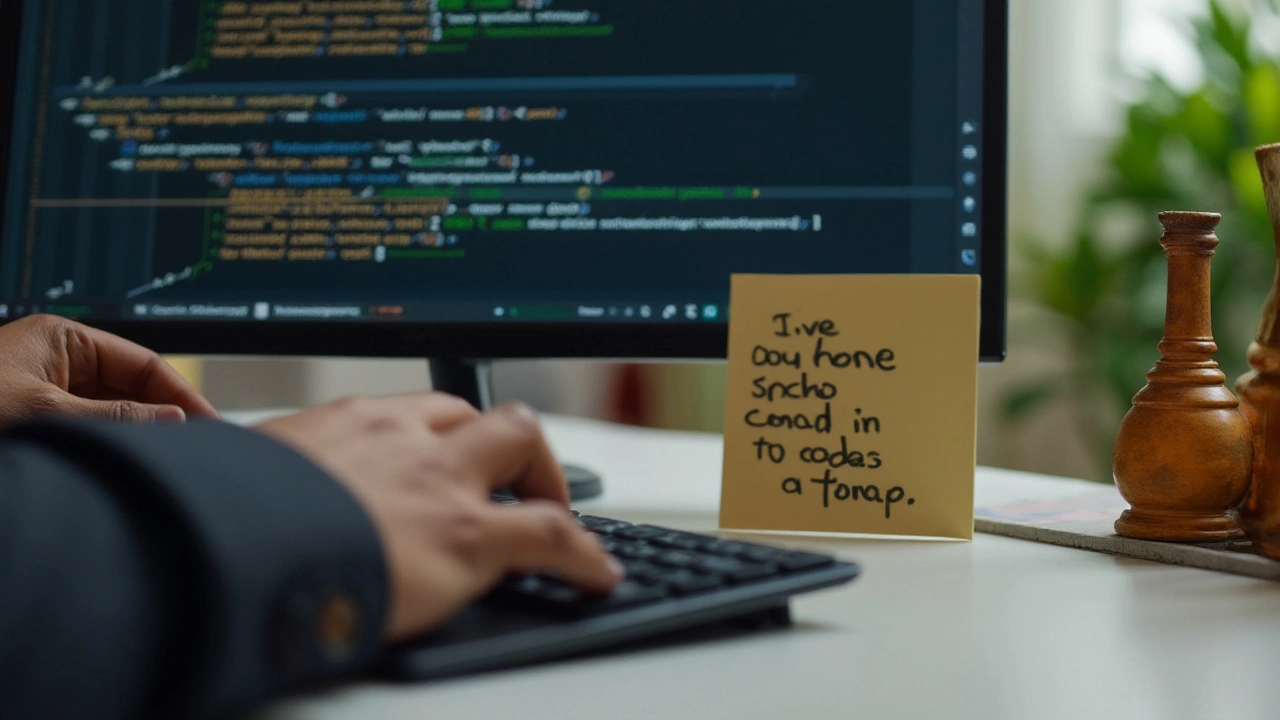The journey into the realm of coding starts with grasping fundamental principles that lay the groundwork for skill advancement. A pivotal aspect, often referred to as the golden rule of coding, is the commitment to writing clear and maintainable code. This isn't just a mantra for newcomers; it’s a timeless principle cherished by coders of all levels.
Writing clear code does more than avert potential errors. It enhances readability, making it straightforward for others to comprehend and contribute efficiently. In a collaborative environment, this can be a game-changer, enabling developers to seamlessly pick up projects, share ideas, and innovate collectively.
By adopting these practices early in your coding journey, you carve a path for continued learning and effective communication within any programming team.
- The Foundation of Coding
- Importance of Clear Code
- Collaboration and Code Sharing
- Practical Tips for Better Coding
The Foundation of Coding
Diving into the world of coding can be as intimidating as it is exciting. The vast sea of programming languages and endless resources often leave beginners wondering where to set their first foot. This initial uncertainty highlights the importance of establishing a strong foundation in coding. It begins with understanding basic concepts, which play a pivotal role as you advance. These fundamentals include data structures, algorithms, syntax, and problem-solving methodologies that apply across various languages, ensuring versatility and adaptability for any aspiring developer.
Every seasoned programmer once started with the basics, emphasizing the need to keep learning simple and focused at the onset. Consider coding as learning a new language; it’s complex and multi-faceted, yet becomes navigable with the right approach. The strong foundation typically involves mastering a single programming language at first, often recommended as Python due to its readability and community support. Understanding variables, loops, and functions at this preliminary stage equips learners to comprehend how different elements work together to form complex programs. Programming languages may differ, but these concepts remain constant, serving as the bedrock for learning future technologies.
Real-world application of coding principles also serves as a crucial component of the foundation. Coding challenges, small projects, and contributing to open-source software provide practical understanding and strengthen theoretical knowledge. To illustrate, renowned computer scientist Donald Knuth once remarked,
“The best way to learn anything is by doing.”Engaging with communities, whether online forums or local meetup groups, can also fortify learning. The shared experiences and insights from peers can demystify challenging concepts and inspire new approaches.
The golden rule of coding shines brightest when the basics are firmly grasped because clarity in these foundational concepts translates into writing better, more maintainable code. Such a foundation isn't merely academic; it helps in scenarios where collaborative projects demand a shared understanding for effective teamwork. These initial steps, taken thorough and slow, form the cornerstone of coding expertise as they guide learners across the unexplored terrains of programming, eventually leading to mastery.

Importance of Clear Code
In the vast and varied realm of coding, the need for clarity cannot be overstated. This is a fundamental principle that underlies not just individual projects but entire coding cultures. Clarity in code makes it easier for developers to understand the purpose and function of each component at a glance. This simplicity reduces the time spent on deciphering complex algorithms and increases focus on innovation and problem-solving. The reality is, clear code saves both time and resources, an essential consideration in commercial and volunteer projects alike. Many challenges faced during code debugging can often be traced back to poorly written code that lacks clarity.
Crafting easily understandable code is not merely beneficial for solitary programmers; it's vital for collaborative teams. Projects involving multiple programmers require a shared understanding. When code is clear, team members can collectively contribute without bogging down the process by revisiting complex or convoluted code blocks. This collaborative synergy can be a catalyst for creativity and efficiency. A crucial benefit here is that it minimizes training time for newcomers stepping into a project. They can integrate swiftly and add value without significant onboarding drudgery.
Writing clear code also significantly impacts the longevity and maintenance of software. As technologies evolve and projects require updates or bug fixes, maintainers benefit immensely from code that clearly outlines its function and logic. This reduces redundancy and the need to re-learn or reverse-engineer parts of the system. Projects often require enhancements long after their initial creation, and a clear coding approach ensures that such enhancements are more seamless and straightforward. Good coding practices, emphasizing clarity, foster better software quality and sustainability, creating a positive cycle of enhancement and innovation.
It's worth recalling a
quote from renowned programmer Martin Fowler, "Any fool can write code that a computer can understand. Good programmers write code that humans can understand."This emphasizes the significance of human readability in programming. At its core, writing clear code isn't just an individual task; it fosters a supportive environment where growth and learning thrive. When beginners encounter clear and understandable code, they find it easier to learn best practices and avoid pitfalls encountered by those who went before.
Notably, lucid code plays a vital role in minimizing errors and improving the quality of the code. When logic and functionality are written in an understandable manner, errors become easier to spot and rectify. This preventive approach saves a lot of time that would be otherwise wasted on bug hunting. Software companies recognize these benefits, sometimes mandating strict style guides that prioritize clear and concise coding. This is because they have understood the direct impact clarity has on a software's success, both in terms of functionality and market competitiveness. In the end, the ability to learn and apply the golden rule of coding by focusing on clarity becomes a crucial differentiator in the programming world.

Collaboration and Code Sharing
Collaboration in coding is an art that is often underestimated, yet it is foundational in creating projects that stand the test of time. When developers come together, the diversity of ideas fuels innovation and problem-solving abilities. But this collaboration doesn't just happen magically. It requires well-written and maintainable code, which serves as a shared language among team members. Clear code acts as a bridge that connects developers, enabling them to contribute effectively without stumbling over bewildering syntax or convoluted logic.
Consider the process of code sharing as the digital equivalent of peer review in academic circles. When coders share their projects on platforms like GitHub, they invite feedback and new perspectives, which can lead to groundbreaking solutions. In this context, a predictable pattern emerges: those who adhere to the golden rule of coding—favoring clarity and simplicity—find their code more accessible to others. This accessibility, in turn, enhances the vigor of collaboration and seeds a culture of continuous learning and sharing.
"Programs must be written for people to read, and only incidentally for machines to execute," remarked Harold Abelson, an influential computer scientist, encapsulating the essence of collaborative coding.Thus, adhering to this philosophy aligns with the golden rule and transforms coding from a solitary endeavor into a collective masterpiece.
Tools and Technologies That Aid Sharing
Today, several tools and platforms empower developers to collaborate effortlessly across geographies. Version control systems like Git facilitate seamless collaboration, allowing multiple programmers to work on the same project without conflicting with each other's contributions. Through this robust platform, the developers can track changes, propose new ones, and revert to previous versions if necessary. Importantly, GitHub, an immensely popular repository hosting service, amplifies these capabilities with features such as issue tracking, project management integration, and continuous integration.
Moreover, code collaboration isn’t limited to seasoned developers. Code boot camps and online coding classes utilize these technologies to instill collaborative habits in beginners. This democratizes the learning process, ensuring the next generation of coders not only write efficient software but also communicate effectively through their code. Coding classes often include pair programming exercises, where two programmers work in tandem at one workstation. One, the 'driver,' writes code while the other, the 'observer,' reviews each line, identifying potential pitfalls and suggesting improvements. This method fosters continuous exchange and learning, reinforcing shared understanding and mutual respect.
Therefore, understanding and implementing the golden rule of coding in collaborative environments is more crucial than ever. It ensures that when many minds converge on a project, they amplify each other's strengths rather than entangle themselves in each other's complicated code.

Practical Tips for Better Coding
In the vast landscape of coding, honing one's skills and optimizing efficiency are never-ending journeys. To truly excel and get the most out of your coding practice, it's pivotal to adopt strategies that not only enhance clarity but also streamline the entire development process. One fundamental yet often overlooked practice is consistently writing comments. While many might find commenting to be tedious, leaving brief explanations for your code serves as a road map for both current and future developers. These comments offer valuable insights into the purpose of each function, preventing confusion and saving time when any changes arise. It's akin to leaving breadcrumbs in the forest—easy to backtrack and adjust where necessary.
Another pivotal strategy revolves around the use of version control systems like Git. Imagine working on a team project where everyone is editing the same document without a reliable way to merge changes seamlessly. Version control is akin to magic for developers, allowing them to track changes, roll back when necessary, and collaborate more effectively. It fosters an environment where programming becomes a communal effort rather than a solitaire endeavor. Moreover, integrating continuous testing ensures that code remains robust and free of errors as new features are developed. The constant feedback loop provided by automated tests is invaluable, minimizing overhead by catching bugs early in the coding process.
Embrace Clean Code Practices
Clean code is a hallmark of professionalism in software development. Begin by adopting meaningful naming conventions; variables and functions should be named based on their intended use. This clarity enhances collaboration by making your code more understandable, thus improving both readability and maintainability. Additionally, sticking to consistent coding styles and indentation can make a huge difference. It might seem trivial, but consistent formatting reduces cognitive load as developers switch between sections of code, enabling them to focus on solving complex problems without being distracted by inconsistencies.
Consider leveraging code linters and formatters. These tools automatically enforce style guidelines and correct minor errors, ensuring uniformity across distinct coding environments. Notably, Robert C. Martin, renowned for his contributions to software craftsmanship, once said:
"Clean code is not written, it's rewritten."This statement underscores the importance of refactoring, which should be viewed not as a sign of weakness but as an opportunity for improvement. Regularly revisiting and optimizing code allows developers to eliminate redundancies, simplify complex logic, and ultimately produce more efficient solutions.
Stay Open to Continuous Learning
Lastly, nurturing an attitude of continual growth is crucial. The tech world evolves rapidly, and what may have been an industry standard yesterday could become obsolete tomorrow. Engaging in coding communities, attending workshops, and consistently exploring new languages and technologies can keep your skills sharp and relevant. By absorbing diverse perspectives, you not only refine your current expertise but also discover fresh, innovative approaches to programming challenges. This proactive attitude towards learning helps in adapting more swiftly to change, ensuring that you remain at the forefront of technological advancement.
